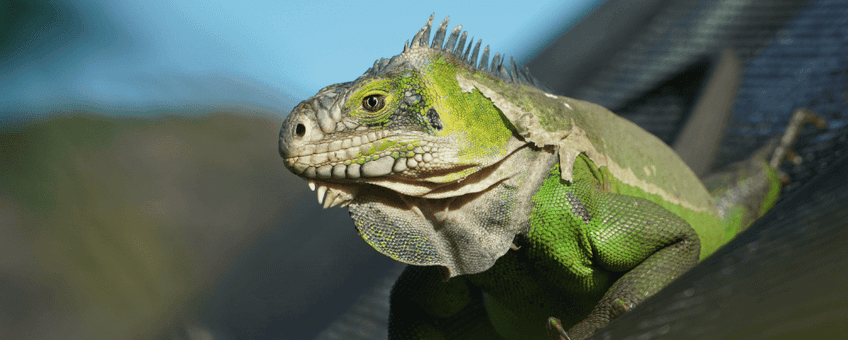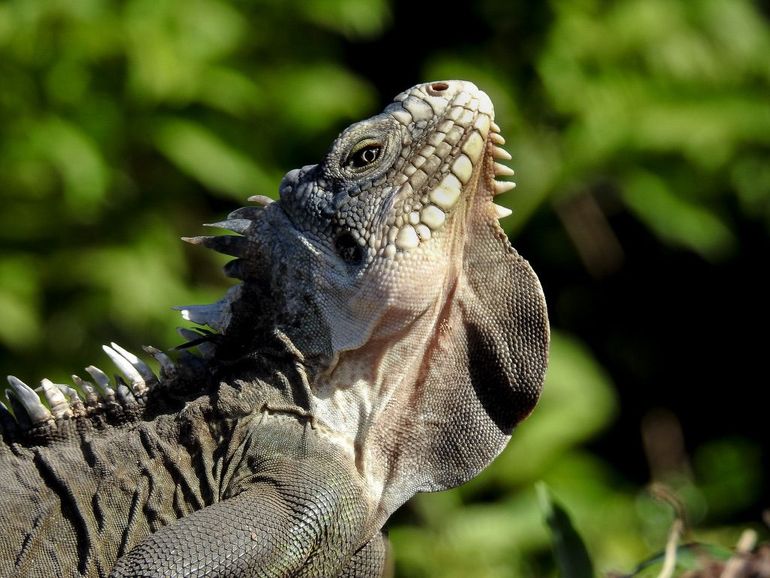
Guana Guardians: safeguarding iguanas for a vibrant future
Dutch Caribbean Nature Alliance (DCNA)The Lesser Antillean iguana (Iguana delicatissima) is a critically endangered species endemic to the Caribbean Lesser Antilles, a chain of islands stretching from the Virgin Islands in the north to Grenada in the south. Within the Dutch Caribbean, since its extinction on Sint Maarten, this iguana can only be found on the island of Statia. These iguanas are typically found in scrub woodlands, dry tropical forests and mangroves, but are also known to venture into human-altered landscapes like abandoned quarries and urban areas.
Distinctive appearance
On Sint Eustatius, the Lesser Antillean iguana is distinguishable by the lack of the large scale on the corner of its jaw and the absence of black stripes on its tail for which the non-native ‘green’ iguanas (Iguana iguana) are known. The confusion with the protected native iguana can be reduced by referring to the non-native species as the 'striped-tailed iguana'. As both the non-native and native species are green during some parts of their life cycle, the use of colors within the name can be confusing. At the date of this publication, there is only one confirmed sighting of a green/striped-tailed iguana on Sint Eustatius. Even though it’s currently only one animal, an adult invasive female iguana can lay a nest of hybrid offspring if she mates with native male iguanas. Over the recent years, more than 10 non-native iguanas have been removed from Statia. The native iguanas have evolved several adaptations that help them thrive in their challenging environments. Their long, muscular tails aid in maintaining balance, enabling them to navigate trees and branches with ease. Moreover, their strong, sharp claws allow them to climb trees and rocky surfaces, providing access to safe havens, typically a nearby burrow, and prime basking spots.

Conservation status and threats
Unfortunately, the Lesser Antillean iguana faces numerous conservation challenges. The International Union for Conservation of Nature (IUCN) has classified this species as Critically Endangered. In addition to habitat loss and degradation due to urbanization, tourism, and the introduction of feral predators (such as cats, dogs and mongooses), the main reason for their decline is competition from introduced green iguanas that continue to threaten the remaining populations. Green iguanas can compete with native iguanas for resources, and interbreeding between the species leads to hybridization; a process through which the native populations is slowly displaced. Additionally, illegal poaching for the pet trade poses a considerable threat, as these charismatic reptiles are sought after as exotic pets.
Conservation efforts
To safeguard the Lesser Antillean iguana, conservation efforts have been implemented across the island of Statia. Protected areas have been established to preserve crucial habitats and prevent further destruction while research and monitoring programs aid in improving overall understanding of the iguanas’ behavior, population dynamics and habitat needs. Furthermore, on Statia, this species is protected under the National Nature Conservation Framework Act BES. Although these steps are important for their protection, it is important that residents and visitors remain vigilant in protecting these local iguanas from the continuous threat of non-native iguanas arriving, for example, from Sint Maarten.
Another important step is to strengthen its protection and legal status further. The Kingdom of the Netherlands will propose to upgrade the Lesser Antillean iguana from Annex III to Annex II of the Protocol Concerning Specially Protected Areas and Wildlife (SPAW). This upgrade would mean that these iguanas would now be under the highest level of protection, meaning the possession, trade, or even disturbance of these species is forbidden.
The Lesser Antillean iguana is a captivating and ecologically significant species that enriches Statia's biodiversity. Given this species’ ecological role and importance as a keystone species in the Caribbean dry forest ecosystem, these iguanas deserve our admiration and improved conservation efforts. By promoting awareness, implementing protective measures, and respecting their natural habitats, we can ensure that future generations can appreciate the beauty and importance of these remarkable reptiles in the Dutch Caribbean.
DCNA
The Dutch Caribbean Nature Alliance (DCNA) supports science communication and outreach in the Dutch Caribbean region by making nature-related scientific information more widely available through, amongst others, the Dutch Caribbean Biodiversity Database, DCNA’s news platform BioNews and the press. This article contains the results from several scientific studies, but the studies themselves are not DCNA studies. No rights can be derived from the content. DCNA is not liable for the content and the in(direct) impacts resulting from publishing this article.
Text: Dutch Caribbean Nature Alliance (DCNA)
Photos: Jasper Raijmakers (lead photo: Lesser Antillean iguana (Iguana delicatissima)); Philippa King
